Mechanical and Hydraulic Properties of Recycled Concrete Aggregates Mixed with Clay Brick Aggregates and Particle Breakage Characteristics for Unbound Road Base and Subbase Materials in Vietnam
Abstract
:1. Introduction
2. Materials and Methods
2.1. Materials
2.2. Compaction, CBR, and Saturated Hydraulic Conductivity Tests
2.2.1. Compaction Test
2.2.2. CBR Test
2.2.3. Saturated Hydraulic Conductivity Tests
2.3. Particle Breakage Analysis after the Compaction Test
3. Results and Discussion
3.1. Compaction Properties
3.2. CBR Properties
3.3. Hydraulic Properties
3.4. Particle Breakage Characteristics for Compacted Samples
3.4.1. Marsal’s Breakage Index
3.4.2. Particle Breakage at Each Size Fraction in the Compaction Process
3.4.3. Percentages of RCA and RCB Retained at Each Fraction after Compaction
4. Conclusions
Author Contributions
Funding
Institutional Review Board Statement
Informed Consent Statement
Data Availability Statement
Acknowledgments
Conflicts of Interest
Appendix A
| TCVN 8859: 2011 [36] | TCVN 8857: 2011 [37] | JIS A 5001:1995 [53] | JRA: 2010 [38] | ||||||||||
| Country | Vietnam | Japan | |||||||||||
| 1. Materials | |||||||||||||
| Labels | Type I | Type II | Type A | Type B | Type C | Type D | C-40 | RC-40 | RM-40 | ||||
| Materials | Crushed stone (natural aggregates) | (1) Crushed stone or gravel (100%) Crushed stone mixed with non-crushed natural aggregates (<50% content) | Natural aggregates (minimized crushing processing) | Crushed stone (natural aggregates) | Recycled aggregates (recycled materials from waste concrete and other materials) | Recycled aggregates (recycled materials from waste concrete and other materials) | |||||||
| 2. Gradation of aggregates | |||||||||||||
| Nominal aperture size of sieve (mm) | Dmax = 37.5 mm (1) (% passing) | Dmax = 25 mm (2) (% passing) | Dmax = 19 mm (3) (% passing) | Dmax ≤ 50 mm (% passing) | Dmax ≤ 25 mm (% passing) | Dmax = 40 mm (% passing) | |||||||
| 53 | 100 | 100 | 100 | ||||||||||
| 50 | 100 | 100 | 100 | - | - | - | |||||||
| 37.5 | 95–100 | 100 | - | - | 95–100 | 95–100 | 95–100 | ||||||
| 26.5 | - | - | - | - | - | - | - | ||||||
| 25 | - | 79–90 | 100 | - | 75–95 | 100 | 100 | - | - | 60–90 | |||
| 19 | 58–78 | 67–83 | 90–100 | - | - | - | - | 50–80 | 50–80 | - | |||
| 9.5 | 39–59 | 49–64 | 58–73 | 30–65 | 40–75 | 50–85 | 60–100 | - | - | - | |||
| 4.75 | 24–39 | 34–54 | 39–59 | 25–55 | 30–60 | 35–65 | 50–85 | 15–40 | 15–40 | 30–65 | |||
| 2.36 | 15–30 | 25–40 | 30–45 | - | - | - | - | 5–25 | 5–25 | 20–50 | |||
| 2.0 | - | - | - | 15–40 | 20–45 | 25–50 | 40–70 | - | - | - | |||
| 0.425 | 7–19 | 12–24 | 13–27 | 8–20 | 15–30 | 15–30 | 25–45 | - | - | 10–30 | |||
| 0.075 | 2–12 | 2–12 | 2–12 | 2–8 | 5–20 | 5–15 | 5–20 | - | - | 2–10 | |||
| TCVN 8859: 2011 [36] | TCVN 8857: 2011 [37] | JIS A 5001:1995 [53] | JRA: 2010 [38] | ||||||||||
| Country | Vietnam | Japan | |||||||||||
| Labels | - | C-40 | RC-40 | RM-40 | |||||||||
| 3. Adaptations and technical specifications | |||||||||||||
| Adaptations (5) | Base layer (A1, A2) | Subbase layer (A1, Base layer (A2, B2) | (1) Subbase layer (A1: Type A, B, C) | (2) Base layer (A2: Type A, B, C) | (3) Subbase layer (A2: Type A, B, C, D) | (4) Base and subbase layers (B1, B2: Type A, B, C, D) | (5) Surface layer (B1, B2: Type A, B, C, D) | Testing method | Subbase layer (lower base) | Subbase layer (lower base) | Base layer (upper base) | Testing method | |
| LL (%) | ≤25 | ≤35 | ≤35 | ≤25 | ≤35 | ≤35 | ≤35 | [54] | - | - | - | - | |
| PI | ≤6 | ≤6 | ≤6 | ≤6 | ≤6 | ≤12 | 9–12 | [54] | Non-plastic | ≤6 | ≤4 | [55] | |
| PP index (6) | ≤45 | ≤60 | - | - | - | - | - | - | - | - | - | - | |
| CBR at K = 98% (%) | ≥100 | - | ≥30 | ≥80 | ≥30 | ≥30 | ≥30 | [41] | - | - | - | - | |
| Corrected CBR (%) (7) | - | - | - | - | - | - | - | - | - | ≥20 (30) (4) | ≥80 (90) (4) | [56] | |
| LA (%) | ≤35 | ≤40 | ≤35 | ≤35 | ≤50 | ≤50 | ≤50 | [57] | ≤40 | ≤50 | ≤50 | [58] | |
| Rate of sieve passing (8) | - | - | ≤0.67 | ≤0.67 | ≤0.67 | - | ≤0.67 | [59] | - | - | - | - | |
| Elongation and flakiness index (%) | ≤18 | ≤20 | - | - | - | - | - | [60] | - | - | - | - | |
| K (%) | ≥98 | ≥98 | - | - | - | - | - | [39] | - | - | - | - | |
| Impurities (%) | - | - | - | - | - | - | - | - | ≤3 | ≤3 | ≤3 | [61] | |
| Environmental safety | - | - | - | - | - | - | - | - | - | Satisfy environmental standards (9) | MOE (10) | ||
References
- Pratap, V.; Bombaywala, S.; Mandpe, A.; Khan, S.U. Chapter 12-Solid waste treatment: Technological advancements and challenges. In Soft Computing Techniques in Solid Waste and Wastewater Management, 1st ed.; Karri, R., Gobinath, R., Dehghani, M.H., Eds.; Elsevier: Amsterdam, The Netherlands, 2021; pp. 215–231. [Google Scholar]
- Nguyen, H.G.; Nguyen, T.D.; Nghiem, H.T.; Tran, V.C.; Kato, A.; Matsuno, A.; Isobe, Y.; Kawasaki, M.; Kawamoto, K. Current management condition and waste composition characteristics of construction and demolition waste landfills in Hanoi of Vietnam. Sustainability 2021, 13, 10148. [Google Scholar] [CrossRef]
- Singh, P.P.; Ambika, S. Chapter 13-Solid waste management through the concept of zero waste. In Emerging Trends to Approaching Zero Waste: Environmental and Social Perspectives, 1st ed.; Hussain, C.M., Singh, S., Goswami, L., Eds.; Elsevier: Amsterdam, The Netherlands, 2021; pp. 293–318. [Google Scholar]
- Nguyen, V.T.; Tong, T.K.; Dang, T.T.H.; Tran, V.T.N.; Nguyen, H.G.; Nguyen, T.D.; Isobe, Y.; Ishigaki, T.; Kawamoto, K. Current status of construction and demolition waste management in Vietnam: Challenges and opportunities. Int. J. Geomate 2018, 15, 23–29. [Google Scholar]
- Yazdani, M.; Kabirifar, K.; Frimpong, B.E.; Shariati, M.; Mirmozaffari, M.; Boskabadi, A. Improving construction and demolition waste collection service in an urban area using a simheuristic approach: A case study in Sydney, Australia. J. Clean. Prod. 2021, 280, 124138. [Google Scholar] [CrossRef]
- Asif, M.; Muneer, T.; Kelley, R. Life cycle assessment: A case study of a dwelling home in Scotland. Build. Environ. 2007, 42, 1391–1394. [Google Scholar] [CrossRef]
- Agamuthu, P. Challenges in sustainable management of construction and demolition waste. Waste Manag. Res. 2008, 26, 491–492. [Google Scholar] [CrossRef] [Green Version]
- Hoang, H.; Ishigaki, T.; Kubota, R.; Yamada, M.; Kawamoto, K. A review of construction and demolition waste management in Southeast Asia. J. Mater. Cycles Waste Manag. 2020, 22, 315–325. [Google Scholar] [CrossRef]
- Norouzi, M.; Chafer, M.; Cabeza, L.F.; Jimenez, L.; Boer, D. Circular economy in the building and construction sector: A scientific evolution analysis. J. Build. Eng. 2021, 44, 102704. [Google Scholar] [CrossRef]
- Lieder, M.; Rashid, A. Towards circular economy implementation: A comprehensive review in context of manufacturing industry. J. Clean. Prod. 2016, 115, 36–51. [Google Scholar] [CrossRef]
- Bocken, N.M.P.; de Pauw, I.; Bakker, C.; van der Grinten, B. Product design and business model strategies for a circular economy. J. Ind. Prod. Eng. 2016, 33, 308–320. [Google Scholar] [CrossRef] [Green Version]
- Esa, M.R.; Halog, A.; Rigamonti, L. Developing strategies for managing construction and demolition wastes in Malaysia based on the concept of circular economy. J. Mater. Cycles Waste Manag. 2017, 19, 1144–1154. [Google Scholar] [CrossRef]
- Ruiz, L.A.L.; Ramon, X.R.; Domingo, S.G. The circular economy in the construction and demolition waste sector–A review and an integrative model approach. J. Clean. Prod. 2020, 248, 119238. [Google Scholar] [CrossRef]
- Poon, C.S.; Chan, D. Feasible use of recycled concrete aggregate and crushed brick as unbound road sub-base. Constr. Build. Mater. 2006, 20, 578–585. [Google Scholar] [CrossRef]
- Aatheesan, T.; Arulrajah, A.; Newman, G.; Bo, M.W.; Wilson, J. Crushed brick blends with crushed concrete for Pavement sub-base and drainage applications. Aust. Geomech. J. 2009, 44, 65–72. [Google Scholar]
- Arulrajah, A.; Piratheepan, J.; Aatheesan, T.; Bo, M.W. Geotechnical properties of recycled crushed brick in pavement application. J. Mater. Civ. Eng. 2011, 23, 1444–1452. [Google Scholar] [CrossRef]
- Cameron, D.A.; Azam, A.H.; Rahman, M. Recycled Clay Masonry and Recycled Concrete Aggregate Blends in Pavement, Geocongress 2012 Geotechnical Special Publication; 20191-4400, GSP 2012; American Society of Civil Engineers: Reston, VA, USA, 2012; Volume 225, pp. 1532–1541. [Google Scholar]
- Kumbhar, S.A.; Gupta, A.; Desai, D.B. Recycling and reuse of construction and demolition waste for sustainable development. OIDA Int. J. Sustain. Dev. 2013, 6, 83–92. [Google Scholar]
- Tang, Z.; Li, W.; Tam, V.W.; Xue, C. Advanced progress in recycling municipal and construction solid wastes for manufacturing sustainable construction materials. Resour. Conserv. Recycl. X 2020, 6, 100036. [Google Scholar] [CrossRef]
- Gao, A.M. Construction & Demolition Waste Management: From Japan to Hong Kong. 2006. Available online: http://ssrn.com/abstract=1131984 (accessed on 12 February 2022).
- European Commission. Resource Efficient Use of Mixed Wastes-Member States Factsheets. 2015. Available online: https://ec.europa.eu/environment/system/files/2021-01/resource_efficient_uses_mixed_waste_Final_Report.pdf (accessed on 12 February 2022).
- Wahia, N.; Josephb, C.; Tawiec, R.; Ikaud, R. Critical review on construction waste control practices: Legislative and waste management perspective. Procedia Soc. Behav. Sci. 2016, 224, 276–283. [Google Scholar] [CrossRef] [Green Version]
- Ministry of Land, Infrastructure, Transport and Tourism (MLIT). Fact-Finding Survey on the Construction By-Products, Japan. 2018. Available online: https://www.mlit.go.jp/sogoseisaku/region/recycle/d02status/d0201/page_020101census.htm (accessed on 12 February 2022). (In Japanese).
- Ministry of Natural Resources and Environment (MONRE). State of Environmental Report 2011 on Solid Waste Management (MONRE); MONRE: Hanoi, Vietnam, 2011. (In Vietnamese) [Google Scholar]
- Papargyropoulou, E.; Preece, C.; Padfield, R.; Adila, A.A. Sustainable construction waste management in Malaysia: A contractor’s perspective. In Proceedings of the International Conference on Management and Innovation for a Sustainable Built Environment (MISBE2011), Amsterdam, the Netherlands, 19–23 June 2011; Wamelink, J.W.F., Geraedts, R.P., Volker, L., Eds.; TU Delft: Amsterdam, The Netherlands, 2011; pp. 1–10. [Google Scholar]
- Chinda, T.; Suteerapongpan, N.; Lapmahanon, K.; Benhadyelias, K.; Santimaethineedhol, P. The feasibility study of the construction waste recycling program in Thailand. In Proceedings of the 4th International Conference on Engineering, Project, and Production Management (EPPM 2013), Bangkok, Thailand, 23–25 October 2013; pp. 1204–1212. [Google Scholar]
- Resolution 34/2007/NQ-CP. A Number of Solutions for the Amelioration and Reconstruction of Damaged or Degraded Condominiums; Vietnamese Government: Hanoi, Vietnam, 2007. (In Vietnamese) [Google Scholar]
- Jimenez, J.R.; Perez, I. Chapter 14 Recycled aggregates (RAs) for roads. In Handbook of Recycled Concrete and Demolition Waste, Woodhead Publishing Series in Civil Engineering: No. 47; Pacheco-Torgal, F., Tam, V.W.Y., Labrincha, J.A., Ding, Y., de Brito, J., Eds.; Woodhead Publishing: Sawston, UK, 2013; pp. 378–393. [Google Scholar]
- Le, H.B.; Bui, Q.B. Recycled aggregate concretes–A state-of-the-art from the microstructure to the structural performance. Constr. Build. Mater. 2020, 257, 119522. [Google Scholar] [CrossRef]
- Thai, H.N.; Kato, A.; Nguyen, H.G.; Nguyen, T.D.; Tong, T.K.; Nguyen, V.T.; Uchimura, T.; Maki, T.; Kawamoto, K. Effects of particle size and type of aggregate on mechanical properties and environmental safety of unbound road base and subbase materials: A literature review. Int. J. Geomate 2021, 20, 149–157. [Google Scholar] [CrossRef]
- Aatheesan, T.; Arulrajah, A.; Bo, M.W.; Vuong, B.; Wilson, J. Crushed brick blends with crushed rock for pavement systems. In Proceedings of the Institution of Civil Engineers, Waste and Resource Management; Powrie, W., Ed.; ICE: London, UK, 2010; Volume 163, pp. 29–35. [Google Scholar]
- Arulrajah, A.; Younus, M.M.; Piratheepan, J.; Bo, M.W. Geotechnical properties of waste excavation rock in pavement subbase applications. J. Mater. Civ. Eng. 2012, 24, 924–932. [Google Scholar] [CrossRef]
- Iqbal, M.R.; Kawamoto, K.; Uchimura, T.; Dung, N.T.; Ton, T.K.; Tuan, N.V.; Giang, N.H. Compaction characteristics and CBR of sludge blended with recycled clay bricks for road subgrade application. Int. J. Geomate 2020, 19, 133–143. [Google Scholar] [CrossRef]
- Fernandes, P.A.; Iqbal, M.R.; Nguyen, V.T.; Nguyen, H.G.; Kawamoto, K. Compaction and CBR properties of recycled concrete aggregates blended with recycled clay brick aggregates for road base and subbase materials in Vietnam. In Proceedings of the 8th International Symposium on Advances in Civil and Environmental Engineering Practices for Sustainable Development (ACEPS2021), SE-7, Gaul, Sri Lanka, 7 October 2021; pp. 62–67. [Google Scholar]
- Thai, H.N.; Nguyen, T.D.; Nguyen, V.T.; Nguyen, H.G.; Kawamoto, K. Characterization of compaction and CBR properties of recycled concrete aggregates for unbound road base and subbase materials in Vietnam. J. Mater. Cycles Waste Manag. 2022, 24, 34–48. [Google Scholar] [CrossRef]
- TCVN 8859. Aggregate Bases and Subbases of Pavement Structure–Material, Construction, and Acceptance; Ministry of Science and Technology: Hanoi, Vietnam, 2011. (In Vietnamese)
- TCVN 8857. Natural Aggregate for Road Pavement Layers–Specification for Material, Construction and Acceptance; Ministry of Science and Technology: Hanoi, Vietnam, 2011. (In Vietnamese)
- Japan Road Association (JRA). Technical Requirements of Recycled Aggregates for Roadbed Materials, Handbook on Pavement Reclamation; JRA: Tokyo, Japan, 2010. (In Japanese) [Google Scholar]
- TCVN 12790. Soils, Aggregates for Transport Infrastructure-Proctor Compaction Test; Ministry of Science and Technology: Hanoi, Vietnam, 2020. (In Vietnamese)
- ASTM D 1557. Standard Test Methods for Laboratory Compaction Characteristics of Soil Using Modified Effort; ASTM International: West Conshohocken, PA, USA, 2012.
- TCVN 12792. Road and Foundation Materials-Standard Test Method for California Bearing Ratio (CBR) in the Laboratory; Ministry of Science and Technology: Hanoi, Vietnam, 2020. (In Vietnamese)
- AASHTO T193. Standard Method of Test for The California Bearing Ratio; AASHTO: Washington, DC, USA, 2013.
- ASTM D 5856. Standard Test Method for Measurement of Hydraulic Conductivity of Porous Material Using a Rigid-Wall, Compaction-Mold Permeameter; ASTM International: West Conshohocken, PA, USA, 2015.
- TCVN 12662. Soil Quality-Determination of Hydraulic Conductivity of Saturated Porous Materials Using a Flexible Wall Permeameter; Mimistry of Science and Technology: Hanoi, Vietnam, 2019. (In Vietnamese)
- Marsal, R.J. Particle breakage. In Embankment-Dam Engineering: Casagrande Volume; Hirschfeld, R.C., Poulos, S.J., Eds.; Wiley: New York, NY, USA, 1973; pp. 130–141. [Google Scholar]
- Disfani, M.M.; Arulrajah, A.; Bo, M.W.; Hankour, R. Recycled Crushed Glass in Road Work Applications. Waste Manag. 2011, 31, 2341–2351. [Google Scholar] [CrossRef] [PubMed]
- Cardoso, R.; Silva, R.V.; Brito, J.; Dhir, R. Use of Recycled Aggregates from Construction and Demolition Waste in Geotechnical Applications: A Literature Review. Waste Manag. 2016, 49, 131–145. [Google Scholar] [CrossRef]
- Iqbal, M.R.; Hashimoto, K.; Tachibana, S.; Kawamoto, K. Geotechnical Properties of Sludge Blended with Crushed Concrete and Incineration Ash. Int. J. Geomate 2019, 16, 116–123. [Google Scholar]
- Arisha, A.M.; Gabr, A.R.; El-Badawy, S.M.; Shwally, S.A. Performance evaluation of construction and demolition waste materials for pavement construction in Egypt. J. Mater. Civ. Eng. 2018, 30, 04017270. [Google Scholar] [CrossRef]
- Diagne, M.; Tinjum, J.M.; Nokkaew, K. The effects of recycled clay brick content on the engineering properties, weathering durability, and resilient modulus of recycled concrete aggregate. Transp. Geotech. 2015, 3, 15–23. [Google Scholar] [CrossRef]
- Hamamoto, S.; Moldrup, P.; Kawamoto, K.; Sakaki, T.; Nishimura, T.; Komatsu, T. Pore network structure of porous media analyzed by micro-focus X-ray computed tomography and linked to particle shape and size and mass transport parameters. Soils Found. 2016, 56, 676–690. [Google Scholar] [CrossRef]
- Baniya, A.; Kawamoto, K.; Hamamoto, S.; Sakaki, T.; Saito, T.; Muller, K.; Moldrup, P.; Komatsu, T. Linking pore network structure derived by micro-focus X-ray CT to mass transport parameters in differently compacted loamy soils. Soil Res. 2019, 57, 642–656. [Google Scholar] [CrossRef]
- JIS A 5001; Crushed Stone for Road Construction: Tokyo, Japan, 1995. (In Japanese)
- TCVN 4197; Soils-Laboratory Methods for Determination of Plastic Limit and Liquid Limit, Ministry of Science and Technology: Hanoi, Vietnam, 2012. (In Vietnamese)
- JIS A 1205; Test Method for Liquid Limit and Plastic Limit of Soils: Tokyo, Japan, 2020. (In Japanese)
- JIS A 1211; Test Methods for the California Bearing Ratio (CBR) of Soils in Laboratory: Tokyo, Japan, 2009. (In Japanese)
- TCVN 7572-12; Aggregates for Concrete and Mortar–Test Methods-Part 12: Determination of Resistance to Degradation of Coarse Aggregate by Abrasion and Impact in the Los Angeles Machine. Ministry of Science and Technology: Hanoi, Vietnam, 2006. (In Vietnamese)
- JIS A 1121; Method of Test for Resistance to Abrasion of Coarse Aggregate by Use of the Los Angeles Machine: Tokyo, Japan, 2007. (In Japanese)
- TCVN 7572-2; Aggregates for Concrete and Mortar–Test Methods-Part 2: Determination of Particle Size Distribution. Ministry of Science and Technology: Hanoi, Vietnam, 2006. (In Vietnamese)
- TCVN 7572-13; Aggregates for Concrete and Mortar–Test Methods-Part 13: Determination of Elongation and Flakiness. Index of Coarse Aggregate: Hanoi, Vietnam, 2006. (In Vietnamese)
- JIS A 5021; Recycled Aggregate for Concrete-Class H: Tokyo, Japan, 2018. (In Japanese)
- 22TCN 211-06; Flexible Pavement Design Procedure. Ministry of Transportation: Hanoi, Vietnam, 2006. (In Vietnamese)
- Soil Contamination Countermeasures Law; MOE: Tokyo, Japan, 2002. (In Japanese)
- Ministry of Environment (MOE). Ministry of Environment (MOE) Notifications No. 46, Environmental Standards for Contamination of Soil; MOE: Tokyo, Japan, 1991. (In Japanese) [Google Scholar]
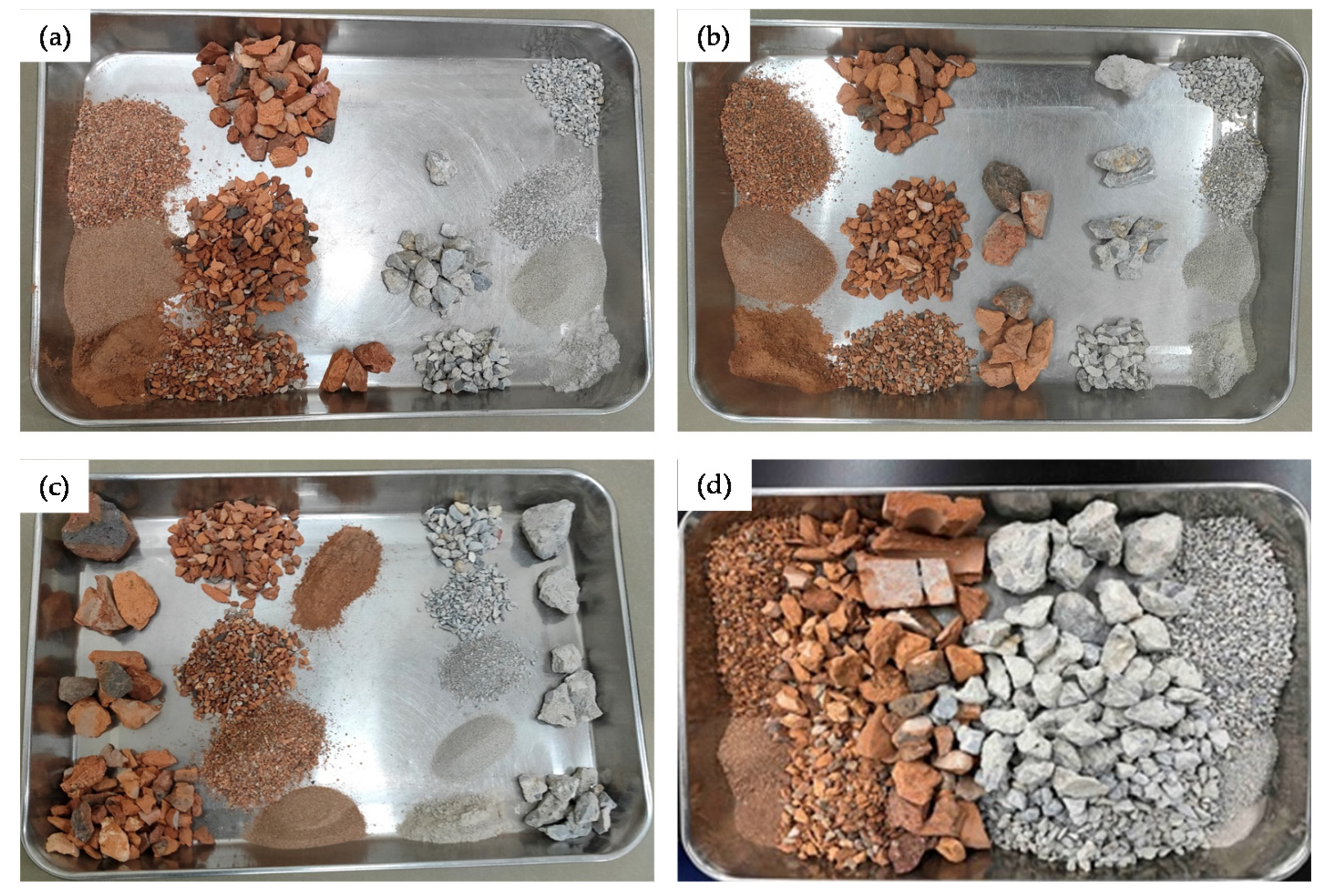
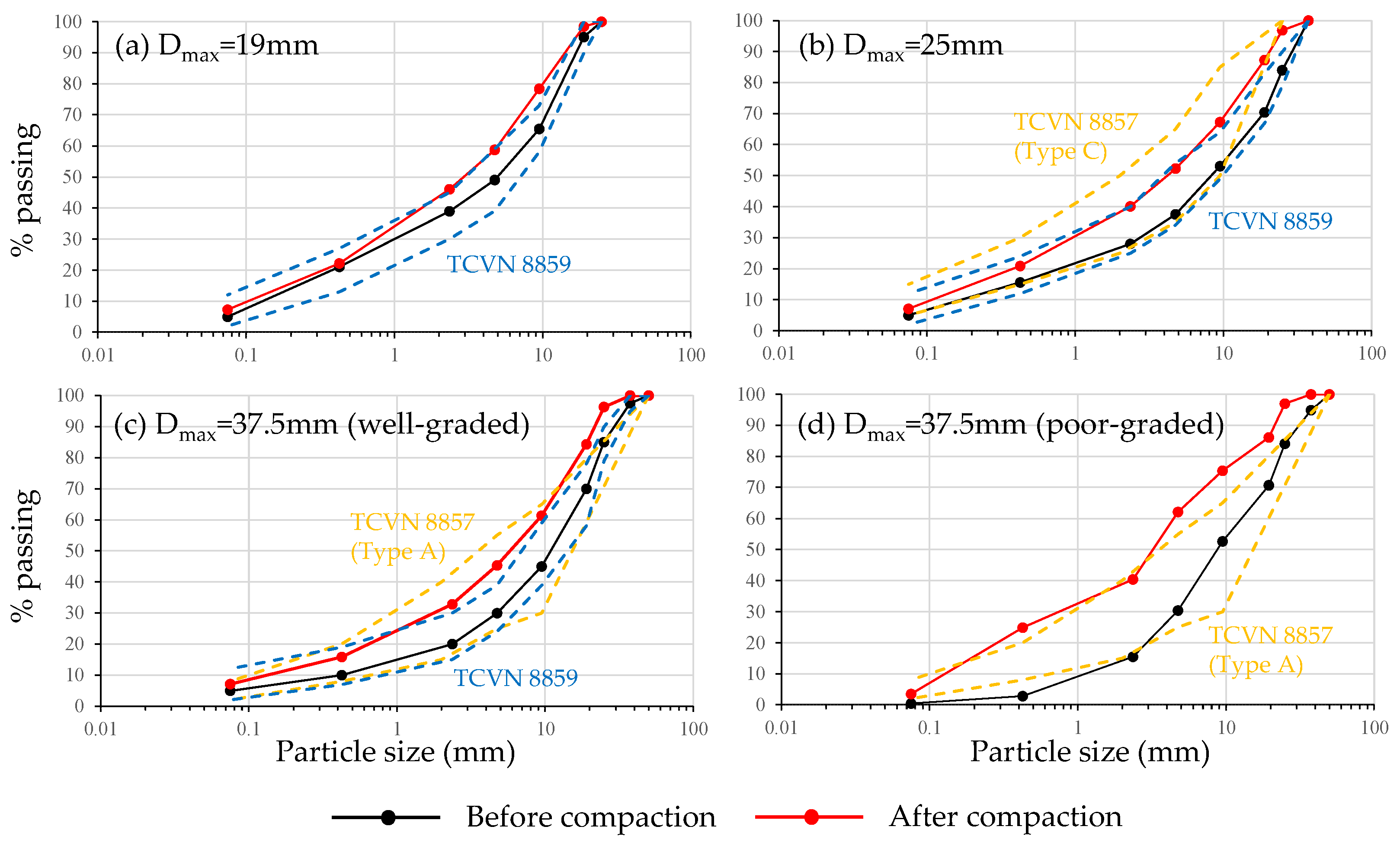
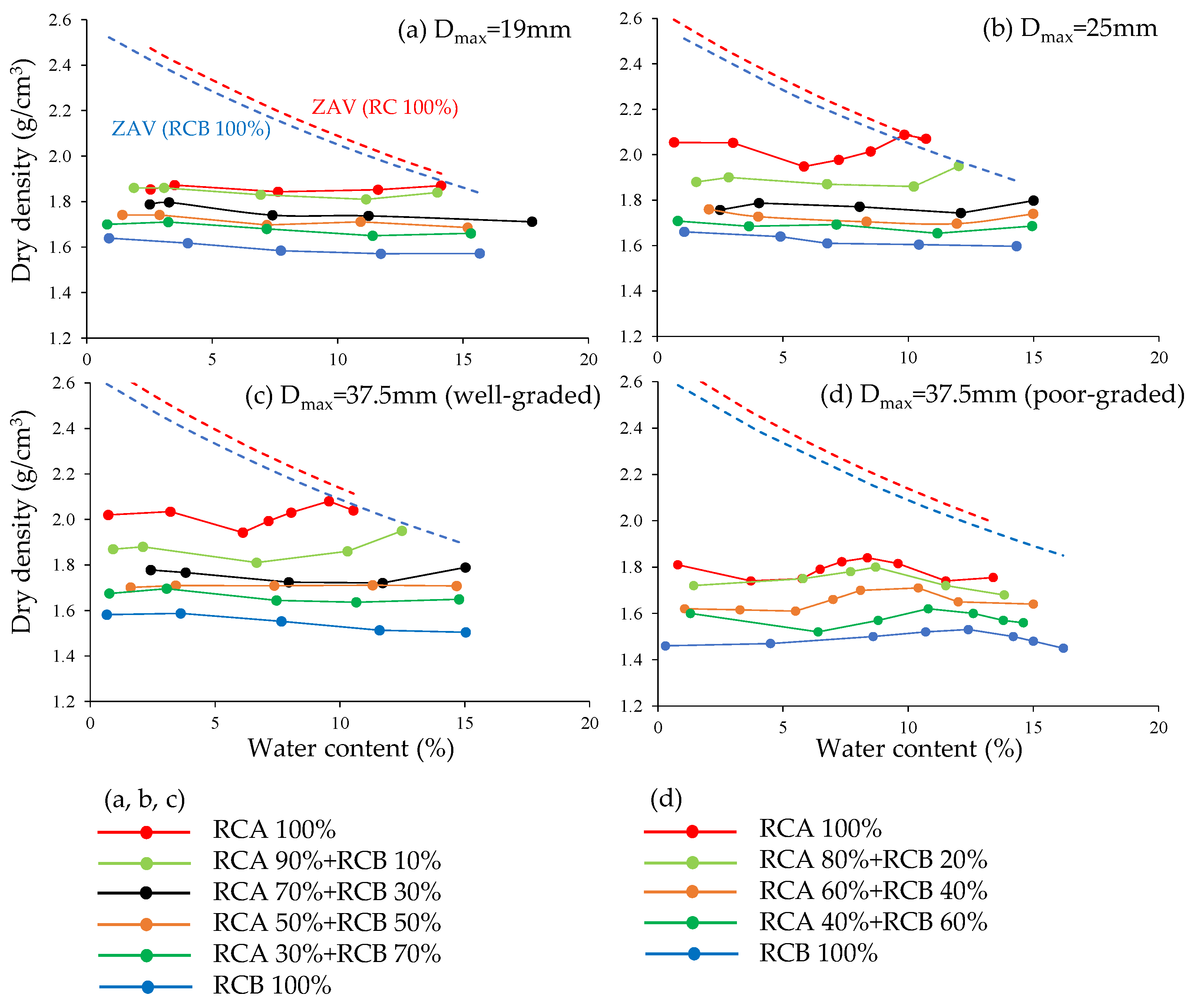
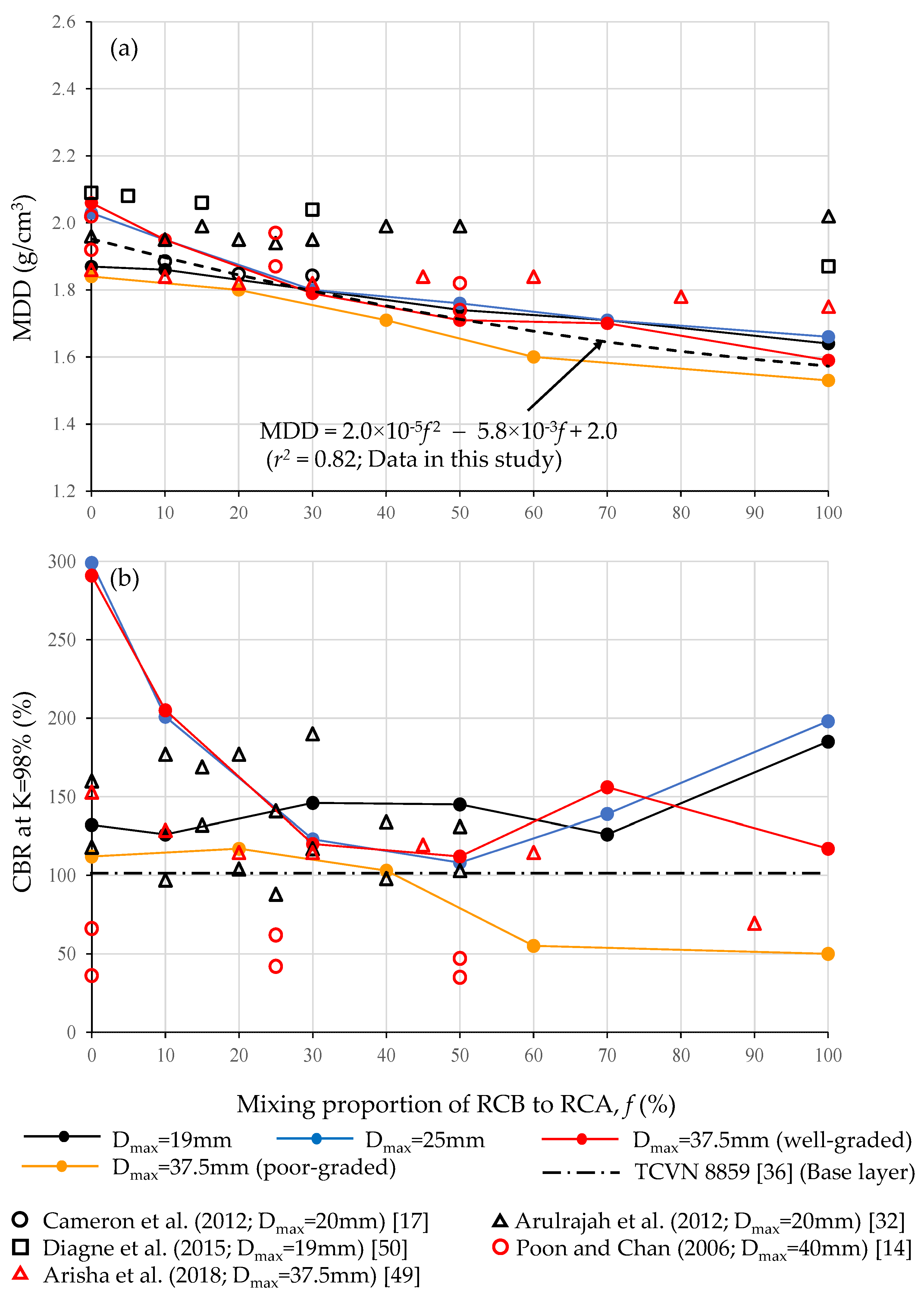
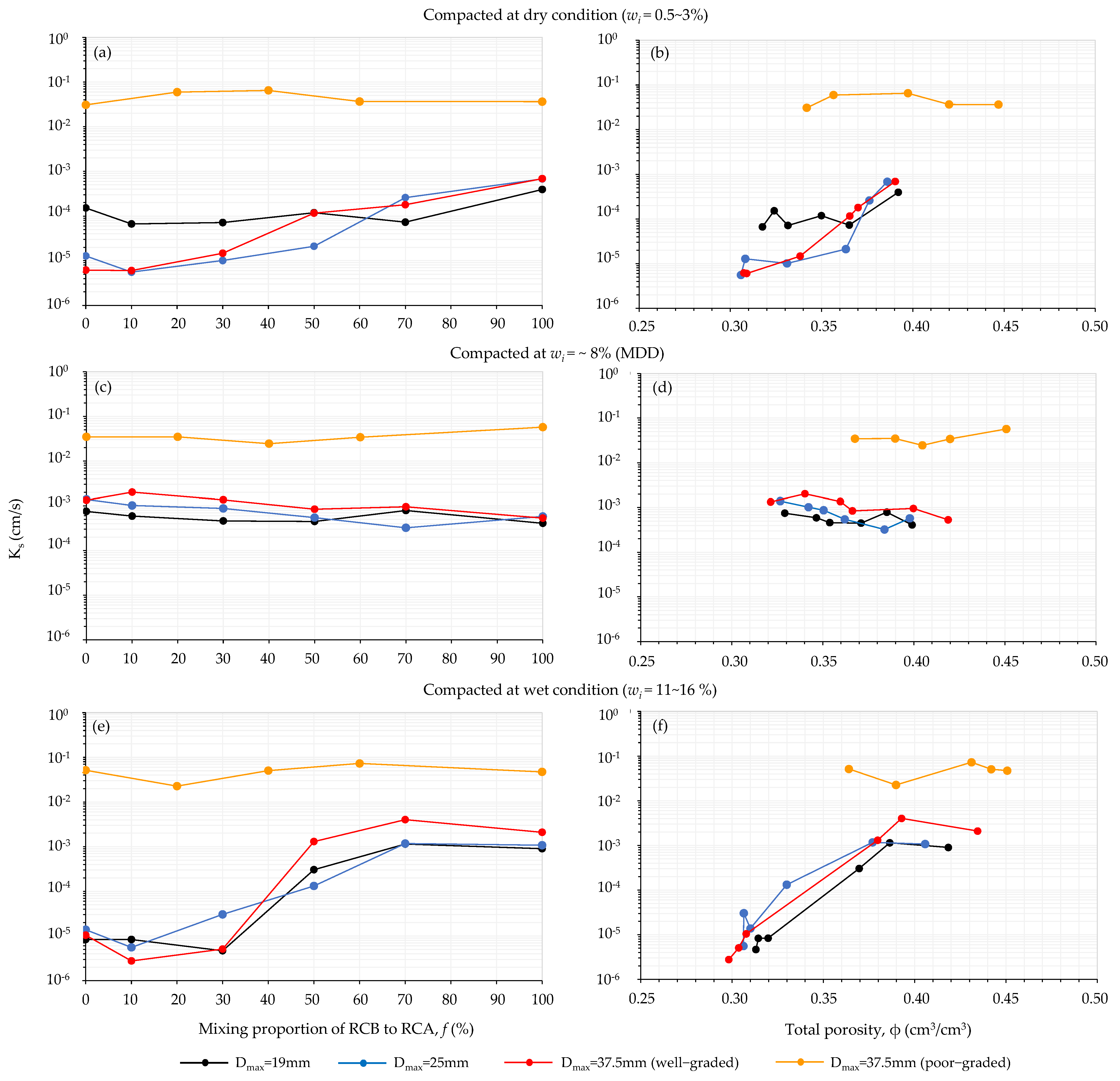


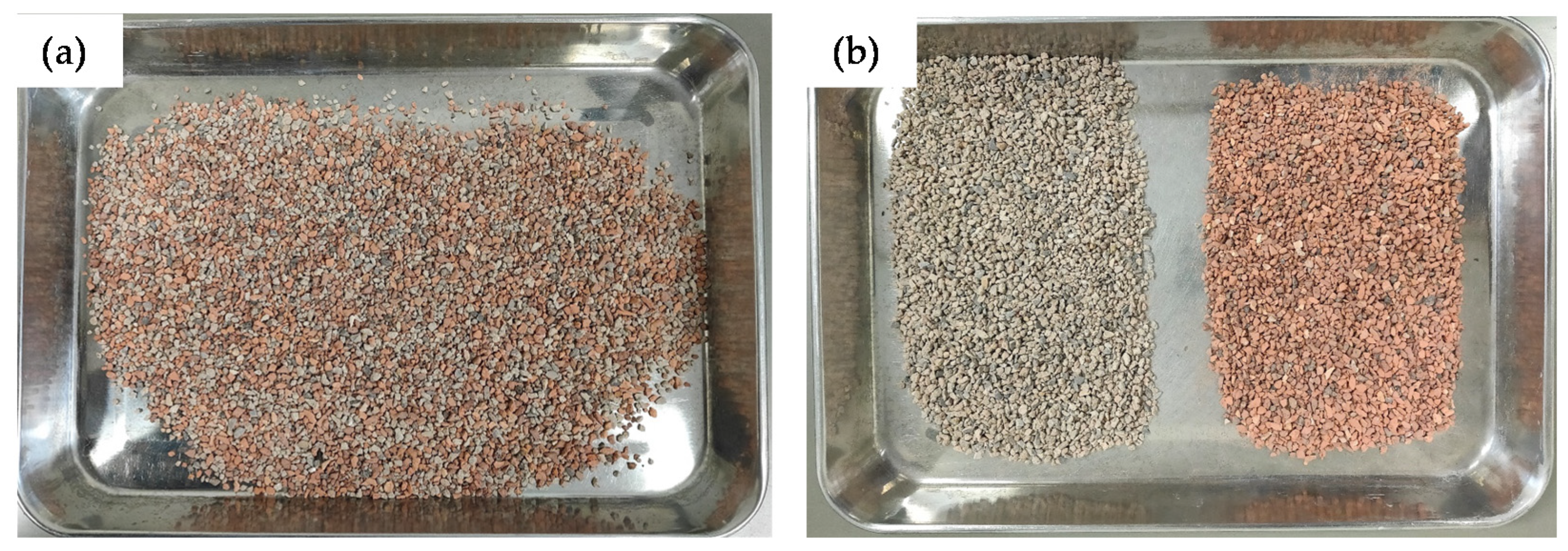
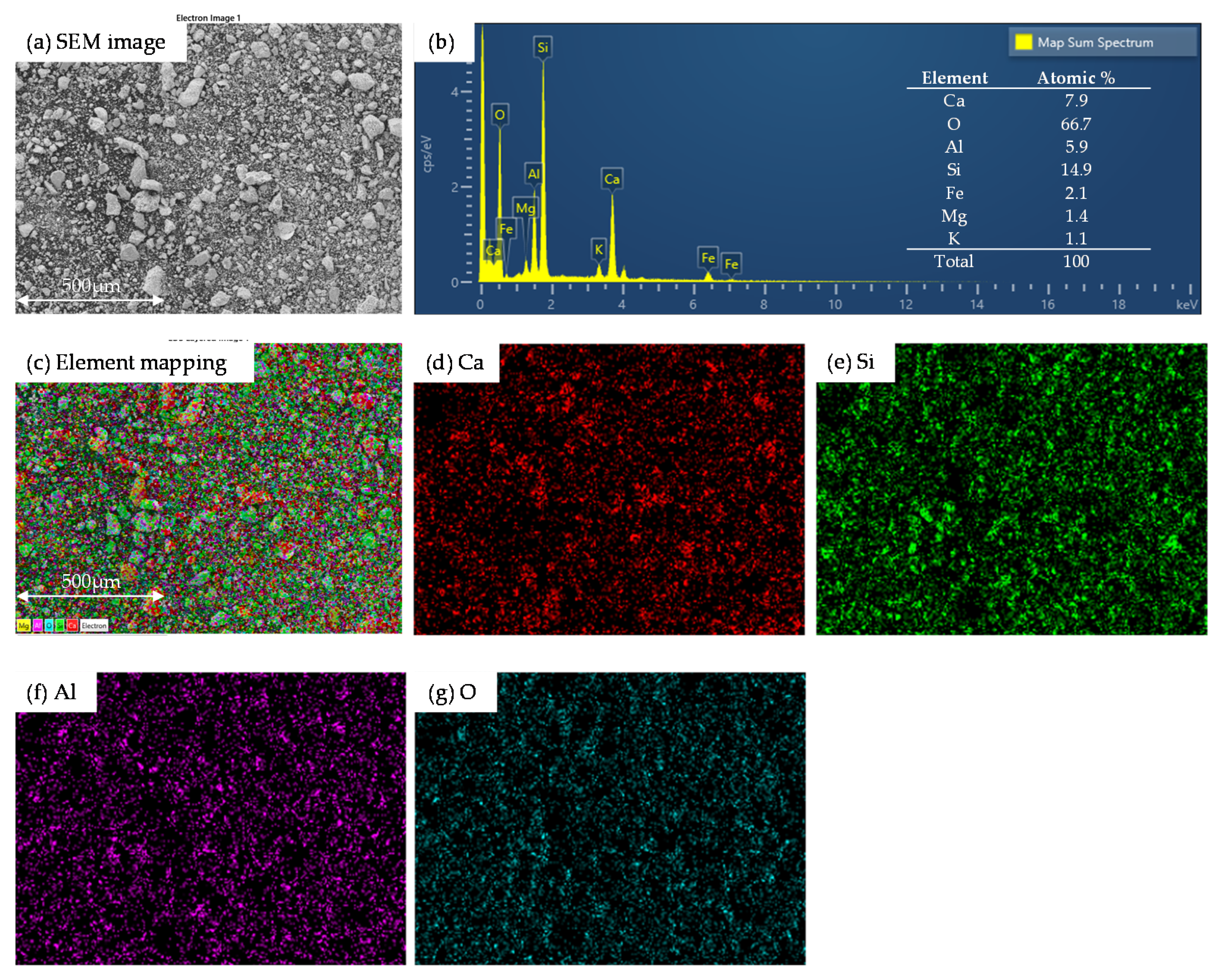
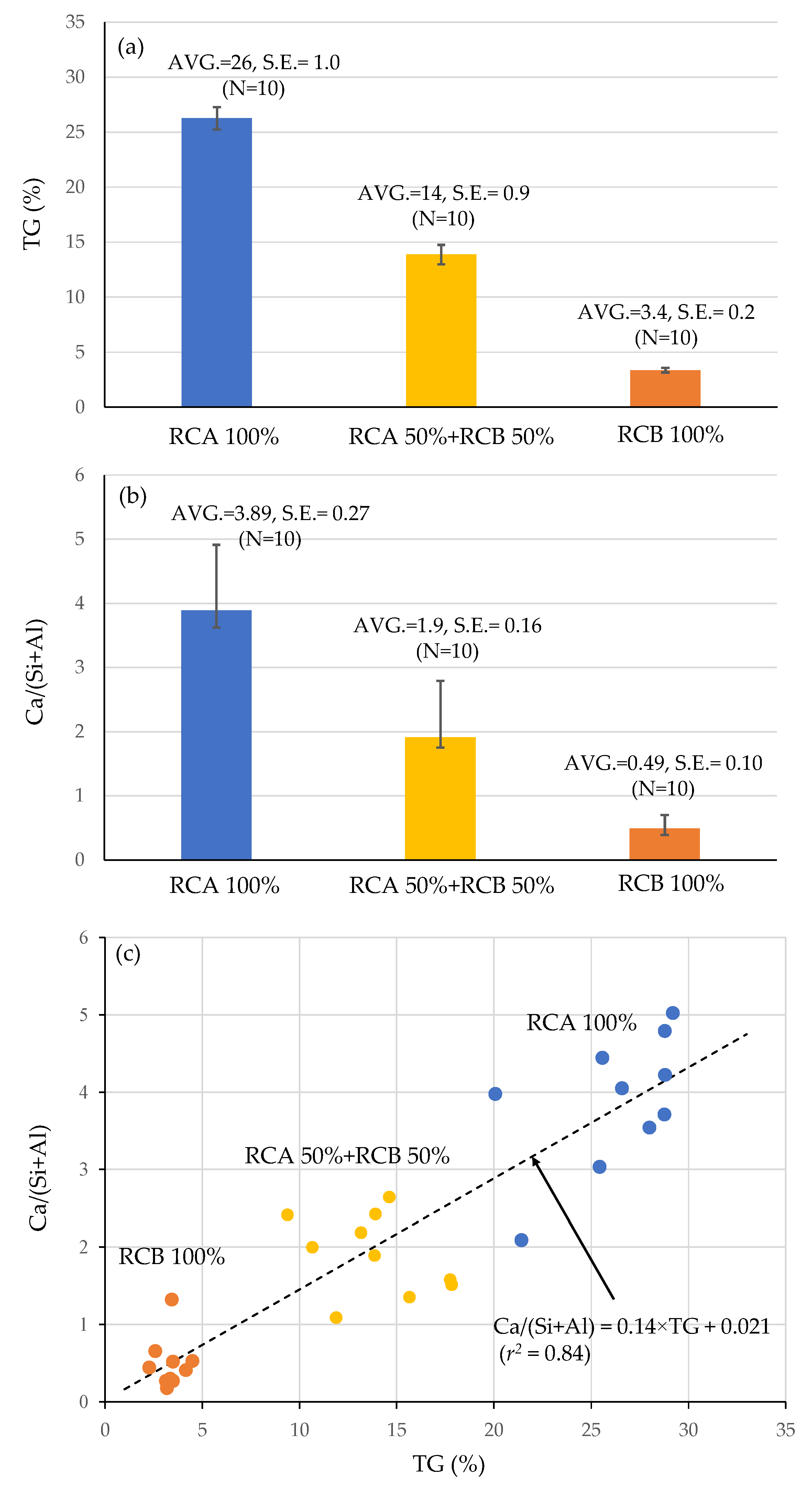
| Samples | Gs | wAD (%) | wabs (%) | pH (1) | EC (1) (mS/cm) | LA (%) | Chemical Component (2) (%) | ||||||
|---|---|---|---|---|---|---|---|---|---|---|---|---|---|
| <4.75 mm | ≥4.75 mm | MgO | Al2O3 | SiO2 | CaO | Fe2O3 | Others | ||||||
| RCA | 2.72 | 0.8 | 8.5 | 5.2 | 11.2 | 4.8 | 34 | 7.3 | 6.3 | 35.4 | 30.9 | 1.7 | 18.4 |
| RCB | 2.64 | 0.3 | 14 | 13 | 10.7 | 0.0 | 46 | 0.9 | 17.9 | 68.2 | 0.6 | 7.5 | 4.9 |
| Samples | Mixing Proportion (%) | MDD (g/cm3) | Bg | CBR at K = 98% (%) | CBR at K = 95% (%) |
|---|---|---|---|---|---|
| Dmax = 19 mm | RCA 100% | 1.87 | 8.3 | 132 | 81 |
| RCA 90% + RCB 10% | 1.86 | 6.4 | 126 | 79 | |
| RCA 70% + RCB 30% | 1.80 | 12.0 | 146 | 78 | |
| RCA 50% + RCB 50% | 1.74 | 14.0 | 145 | 76 | |
| RCA 30% + RCB 70% | 1.71 | 10.5 | 126 | 79 | |
| RCB 100% | 1.64 | 14.8 | 185 | 117 | |
| Dmax = 25 mm | RCA 100% | 2.03 | 7.2 | 299 | 249 |
| RCA 90% + RCB 10% | 1.95 | 13.4 | 201 | 146 | |
| RCA 70% + RCB 30% | 1.80 | 16.9 | 123 | 79 | |
| RCA 50% + RCB 50% | 1.76 | 17.5 | 108 | 64 | |
| RCA 30% + RCB 70% | 1.71 | 18.1 | 139 | 71 | |
| RCB 100% | 1.66 | 27.1 | 198 | 132 | |
| Dmax = 37.5 mm | RCA 100% | 2.06 | 9.3 | 291 | 248 |
| (well–graded) | RCA 90% + RCB 10% | 1.95 | 15.2 | 205 | 161 |
| RCA 70% + RCB 30% | 1.79 | 19.4 | 120 | 84 | |
| RCA 50% + RCB 50% | 1.71 | 16.4 | 112 | 81 | |
| RCA 30% + RCB 70% | 1.70 | 18.7 | 156 | 109 | |
| RCB 100% | 1.59 | 21.8 | 117 | 76 | |
| Dmax = 37.5 mm | RCA 100% | 1.84 | 11.2 | 112 | 73 |
| (poor–graded) | RCA 80% + RCB 20% | 1.80 | 12.2 | 117 | 79 |
| RCA 60% + RCB 40% | 1.71 | 12.8 | 103 | 63 | |
| RCA 40% + RCB 60% | 1.60 | 16.4 | 55 | 36 | |
| RCB 100% | 1.53 | 21.0 | 50 | 37 |
| Sample: Dmax = 25 mm (Compacted at wi = ~8%: MDD) | |||||||||
|---|---|---|---|---|---|---|---|---|---|
| Method | Hand Sieving | Estimated by a Multi Regression Analysis (1) | |||||||
| Fraction (mm) | 25–37.5 | 19–25 | 9.5–19 | 4.75–9.5 | 2.36–4.75 | 0.425–2.36 | 0.075–0.425 | <0.075 | |
| RCA 90% + RCB 10% | RCA | 100 ↑ | 49 ↓ | 68 ↓ | 37 ↓ | 45 ↓ | 56 ↓ | 70 ↓ | 72 ↓ |
| RCB | 0 ↓ | 51 ↑ | 32 ↑ | 63 ↑ | 55 ↑ | 44 ↑ | 30 ↑ | 28 ↑ | |
| RCA 70% + RCB 30% | RCA | 100 ↑ | 82 ↑ | 74 → | 74 → | 71 → | 24 ↓ | 28 ↓ | 10 ↓ |
| RCB | 0 ↓ | 18 ↓ | 26 → | 26 → | 29 → | 76 ↑ | 72 ↑ | 90 ↑ | |
| RCA 50% + RCB 50% | RCA | 51 → | 48 → | 54 → | 50 → | 46 → | 23 ↓ | 26 ↓ | 23 ↓ |
| RCB | 49 → | 52 → | 46 → | 50 → | 54 → | 77 ↑ | 74 ↑ | 77 ↑ | |
| RCA 30% + RCB 70% | RCA | 49 ↑ | 35 → | 37 → | 37 → | 40 ↑ | 18 ↓ | 12 ↓ | 28 → |
| RCB | 51 ↓ | 65 → | 63 → | 63 → | 60 ↓ | 82 ↑ | 88 ↑ | 72 → | |
Publisher’s Note: MDPI stays neutral with regard to jurisdictional claims in published maps and institutional affiliations. |
© 2022 by the authors. Licensee MDPI, Basel, Switzerland. This article is an open access article distributed under the terms and conditions of the Creative Commons Attribution (CC BY) license (https://creativecommons.org/licenses/by/4.0/).
Share and Cite
Nguyen, T.L.; Nguyen, V.T.; Nguyen, H.G.; Matsuno, A.; Sakanakura, H.; Kawamoto, K. Mechanical and Hydraulic Properties of Recycled Concrete Aggregates Mixed with Clay Brick Aggregates and Particle Breakage Characteristics for Unbound Road Base and Subbase Materials in Vietnam. Sustainability 2022, 14, 4854. https://doi.org/10.3390/su14084854
Nguyen TL, Nguyen VT, Nguyen HG, Matsuno A, Sakanakura H, Kawamoto K. Mechanical and Hydraulic Properties of Recycled Concrete Aggregates Mixed with Clay Brick Aggregates and Particle Breakage Characteristics for Unbound Road Base and Subbase Materials in Vietnam. Sustainability. 2022; 14(8):4854. https://doi.org/10.3390/su14084854
Chicago/Turabian StyleNguyen, Trong Lam, Van Tuan Nguyen, Hoang Giang Nguyen, Akihiro Matsuno, Hirofumi Sakanakura, and Ken Kawamoto. 2022. "Mechanical and Hydraulic Properties of Recycled Concrete Aggregates Mixed with Clay Brick Aggregates and Particle Breakage Characteristics for Unbound Road Base and Subbase Materials in Vietnam" Sustainability 14, no. 8: 4854. https://doi.org/10.3390/su14084854
APA StyleNguyen, T. L., Nguyen, V. T., Nguyen, H. G., Matsuno, A., Sakanakura, H., & Kawamoto, K. (2022). Mechanical and Hydraulic Properties of Recycled Concrete Aggregates Mixed with Clay Brick Aggregates and Particle Breakage Characteristics for Unbound Road Base and Subbase Materials in Vietnam. Sustainability, 14(8), 4854. https://doi.org/10.3390/su14084854








